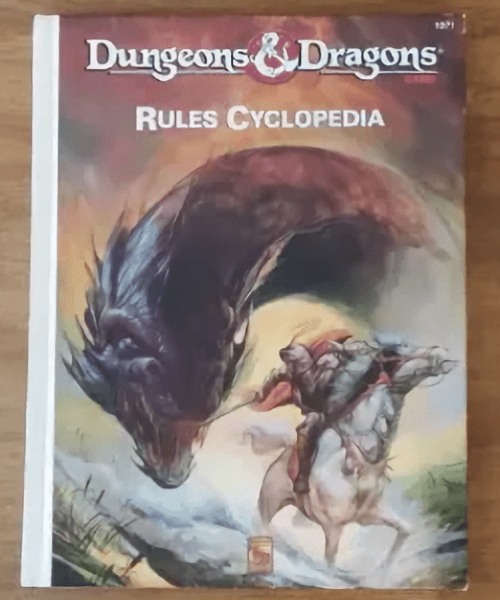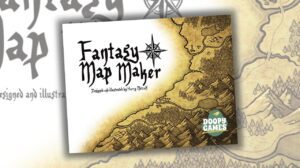Yes, there are two paths you can go by, but in the long run there’s still time to change the road you’re on. – Stairway to Heaven (Led Zeppelin)
An Alternate History
Dungeons & Dragons (D&D) has a long and proud history. The one most people are familiar with, beyond the d20 iterations, is the Advanced Dungeons & Dragons (AD&D) line. If asked, I suspect most people familiar with the game would list the history of the game as follows:
- Chainmail: a set of combat rules; proto-role-playing. Primarily a war game.
- Original Dungeons and Dragons (OD&D): the original true role-playing game. Heavily rooted in its wargaming past.
- Advanced Dungeons and Dragons (AD&D): E. Gary Gygax’s magnum opus. The three books which make up this version of the game (Dungeon Master’s Guide, Player’s Handbook, and Monster Manual) are the focus to which all other games point.
- Advanced Dungeons and Dragons 2nd Edition (AD&D 2e): this is the version of the game designed by the people at E. Gary Gygax’s company after they kicked E. Gary Gygax out of it.
- Dungeons and Dragons 3rd Edition (D&D 3e; d20 System): after Tactical Simulations Rules (TSR) folded and was purchased by Wizards of the Coast, this was the result. The d20 System was the core of those rules presented in a way that could be used by other companies to make compatible material.
- Dungeons and Dragons version 3.5 (D&D 3.5; d20 System 3.5): it was not long after that a revised version was released. Things stayed mostly the same, with odd shifts and rules changes that could cause some confusion. I still believe this should have been a D&D 3e revised.
- Dungeons and Dragons 4th Edition (D&D 4e): a new approach to the game, this version fell short for some in a lot of ways.
- Dungeons and Dragons 5th Edition (D&D 5e): originally called Next Edition while it was in development, this edition made many strides to erase the memory of 4th Edition. Some have even said that this edition makes many callbacks to the old days.
- OneDnd: this is not really a 6th Edition; and it is not really 5th Edition. This is the way forward, as Wizards of the Coast considers the game a living document, with any and all changes just coming with new releases and no new edition being released. Not sure how this is going to work…
But there is another.
The original TSR strategy was two-pronged. In 1977, not only was the hardcover Advanced game being published, but they were also publishing boxed sets for a Basic game. The original Dungeons & Dragons Basic Set boxed edition was edited by John Eric Holmes. According to Wikipedia, he “preferred a lighter tone with more room for personal improvisation,” while the AD&D line “was designed to create a tighter, more structured game system than the loose framework of the original game.”
In 1981, Tom Moldvay was tasked with revising the Basic Set to make it even simpler. David ‘Zeb’ Cook would write a follow-up, the Expert Set, which would allow players of the rules-set to continue beyond the early levels. This formed the core of what would be known as the Basic-Expert (or B/X) rules.
In 1983, Frank Mentzer’s revisions to these two sets would be released. His revisions would include structuring the rules into a sort of step-by-step format that would gradually introduce the player and the Dungeon Master to the rules. New, more advanced concepts would build upon the foundation of the earlier segments. These two sets would be quickly followed by the Companion Set (1983), the Master’s Set (1985), and the Immortals Set (1986). Together, this would often be referred to as the BECMI version of the game. It remains the most beautiful set of rules for the Dungeons & Dragons line ever produced.

The Mentzer Rules
- The Basic Set: character creation; basic game-play; basic spells, combat, and task resolution; character advancement from levels 1 to 3.
- The Expert Set: expert game-play; more advanced spells, combat, and task resolution; character advancement from levels 4 to 14.
- The Companion Set: narrative-based game-play and character options; character advancement from levels 15 to 25.
- The Master’s Set: master-level gameplay; master-level spells, combat, and task resolution; character advancement from levels 26 to 36.
- Wrath of the Immortals: becoming a demi-god; playing with the mortals as pawns; narrative-based immortal role-playing.
The Basic and Expert Sets (B/X)
Frank Mentzer took a set of core rules and created the most open, flexible, and amazing role-playing system that had ever been devised.
This Basic Set box included a Player’s Manual, a Dungeon Master’s Rulebook, and some additional material to get the new gamer started down the road to a lifelong hobby of the imagination. But this basic set was nothing more than an appetizer. The rules would work for your game group for a few months at the most! Character creation was described, and the earliest levels of advancement were handled. Once your character reached 3rd level—someone who starts to show some real promise—you have reached the limit. You cannot go any further.
The Expert Set takes over from there. This box set had rules covering characters from 4th level to 14th level (arguably, the meat of the adventuring career). More monsters, more spells, more weapons and equipment. This set contained things that the players may not have considered prior (such as adventuring in the wilderness as opposed to the dungeon settings prescribed in the Basic Set or mapping that same wilderness).
Where AD&D throws the whole of the world in your face and expects you to trim it down to the relevant sections for your group, the Basic Set introduces role-playing as a concept, then expands upon it in the Expert Set to include new forms of adventure. But the rules did not stop there! There is a lot that can still be done. And for that, we reach the Companion rules!
The Companion Set
The Companion Set covers levels 15 to 25. It introduces new forms of adventure and new forms of combat and gives advice to the players and the Dungeon Master on how to create and rule their own lands. The character paths diverge from those that remain landed to those that choose to roam the lands, continuing to seek adventure and the unknown.
Are you a cleric? Clergy can settle down to establish a church and rise within the theocratic hierarchy… or they can leave the administration of the church to others as they wander the lands spreading the word to the multitudes.
Are you a fighter? Fighters can settle down to establish a dominion and rise within the noble ranks… or they can forsake such duties and become a Paladin, a Knight, or an Avenger.
Are you a magic-user? Magic-users can settle down as a wizard or maga to establish a tower attracting young pupils seeking arcane knowledge… or they can wander the lands as a magus, gathering information and rumor as they go.
I cannot stress this enough:
- E. Gary Gygax (AD&D) focused almost entirely on the game mechanics of high-level characters: when you reach level ‘X,’ you get access to special ability ‘Y’ and can cast spells from list ‘Z.’
- Frank Mentzer (BECMI) gave you rules for advancement, but spent the bulk of the text on the role-playing ramifications of high-level characters: when you reach level ‘X’, the possibilities of establishing yourself as a hero of type ‘A’, ‘B’, or ‘C’ (as discussed below) are open to you.
This is what made Frank Mentzer and his almost forgotten line of Dungeons & Dragons history so beautiful: simple organization, staggered implementation, and continued advice. Nothing like what is seen in the Companion Set existed in AD&D or the post-TSR editions.
Sure, AD&D gave costs for strongholds and the like, but these rules were given no more consideration than any other rule. The mechanics were described, but devoid of implications. The rules were packed into the opaque density of the Dungeon Master’s Guide without fanfare and left unmarked to be discovered whenever a Dungeon Master had the fortune to see them.
Frank Mentzer’s approach was organic. You start here. Once you have those concepts mastered, we will move on to these concepts. Ad Astra.
Master’s Set
The Basic Set gave you the core rules. The Expert Set expanded upon these rules. The Companion Set expanded upon the concepts and implications of high-level characters. The Master’s Set was the culmination of everything. In this boxed set, we found:
- Master combat options
- High-level spells
- Extremely-high level monsters
- A multitude of character options
- Character advancement from level 26 to 36
Once character roles and responsibilities are established—things that do not require rules but need a steady hand at adjudication—you are ready for the Master’s Set. This is a return to the realm of rules where you look at highly advanced and specialized combat options; spell options; and so on.
In the Master’s Set, weapons cease being a one-or-two-handed weapon dealing ‘X’ damage. They take on a role in-and-of themselves, with options indicating how that weapon is used in combat when fighting an unarmed foe or when fighting an armed foe. The options were seemingly limitless!
One can ask why these rules did not exist in the Basic, Expert, or Companion Sets.
And this is a valid question. There is nothing inherent about the rules which prevents them from being used in lower-level games. In fact, once you have the Master’s Set, the rules for weapon training and specialization are certainly usable by characters just starting out in the Basic levels or advancing through the Expert or Companion levels.
But there is something about them that requires that you—the player and the Dungeon Master—have a firm grasp of the core rules before you attempt to use them. Combat, as presented in the earlier box sets, was quick and deadly. One or two dice rolls each round was all that was needed. A fighter need only decide who his target would be. With the combat options presented in the Master’s Set, the fighter needs to decide who his allotted number of parries would be assigned to, who would get the benefits of his potential knockout blows, and so on. The battlefield becomes rife with dramatic descriptions and potential combat flair!
Again—nothing like this existed in any other edition of Dungeons & Dragons.
Nothing at all.

Wrath of the Immortals
The final chapter in the BECMI saga is Wrath of the Immortals. This was a set that transcended epic fantasy and went for the ultimate prize: immortal power.
The books in this set offered you the opportunity to cease playing in the petty wars and squabbles of mortal kingdoms and instead start playing with mortals as pawns on the celestial chessboard. You were to rise and become a demigod, a being of such frightful power that the ideas of attributes and character level started to become blurry and unimportant.
Other editions of Dungeons & Dragons gave us books such as Deities & Demigods, which reduced gods, goddesses, and god-like beings to the stat block used for monsters in the Monster Manual. Zeus became a 400-hit-point monster. A powerful monster, sure, but nothing more. AD&D had missed the mark and was far less advanced in its approach than BECMI; later editions were better but still not as good as Immortals.
Immortal beings in BECMI were awe-inspiring and powerful. And thanks to Frank Mentzer and his team, it was manageable. You could play as an immortal, even gain power as an immortal, all while having stories and adventures that challenged you on the level at which you were playing the game. From political intrigue to combat—these books helped the Dungeon Master to run those games without them devolving.
The key was advice. You can hand a Dungeon Master a set of rules and expect them to follow them. But you cannot set rules for everything a creative player can come up with. So, the game—at all levels—focused on the gameplay as a concept and gave guidelines for how to use, stretch, apply, and modify those rules to suit the situation.
It was, and will ever remain, the best Dungeons & Dragons has ever had to offer.

The Rules Cyclopedia
In 1991, TSR released a hardcover edition of the BECMI system. This book, called The Rules Cyclopedia, took all of the material from the Basic, Expert, Companion, Master’s, and Immortals Sets and reorganized them into a cohesive whole.
- All of the combat rules—basic combat, advanced combat options, weapon training, and specialization—put into a single, comprehensive whole.
- All of the spells—low, mid, and high-level—were placed into one chapter and ordered properly.
- All of the monsters—one chapter, organized alphabetically.
- High-Level campaigns, dungeon and wilderness mapping, advanced character options, immortals rules … all of it.
This book was compiled and developed by Aaron Allston, one of the guys most responsible for the Immortals books. This book has its flaws, but overall, it is an amazing feat. This book has more relevant material for a player or Dungeon Master packed into 300 pages than any other edition of Dungeons and Dragons.
It is time!
Writing this, it is my intent to shine a light into a dark corner of the Dungeons & Dragons timeline. But more than that, I want Wizards of the Coast to acknowledge this branch of the game’s history. So far, they have produced beautiful, high-quality reprints for:
- Original Dungeons and Dragons — a beautiful wooden box with the digest-sized volumes that made up the old rules that launched a revolutionary new hobby.
- Advanced Dungeons and Dragons 1st Edition — with faux-leather covers and beautiful gold-leaf paper, the original Dungeon Master’s Guide, Player’s Handbook, and Monster Manual have been reproduced. These were later followed up with Unearthed Arcana (a book that expanded the number of spells and such but offered little else of use) and even a group of adventure modules in the format. All books included all known errata.
- Advanced Dungeons and Dragons 2nd Edition — again, gorgeous in their reproduction, these books cover the core three books (Dungeon Master’s Guide, Player’s Handbook, and Monster Manual). They did not get faux-leather covers but were masterfully produced. All books included all known errata.
- Dungeons and Dragons version 3.5 — using the artistic style that defined the 3.x editions, these reproductions of the three core books (Dungeon Master’s Guide, Player’s Handbook, and Monster Manual) are beautiful. A few other volumes were included, such as the Spell Compendium and the Magic Item Compendium. All books included all known errata.
Each of these was assembled with obvious care and reverence. I love them all! To date, nothing along these lines has been done for the BECMI editions. I find this not only sad but incredibly disrespectful to the game’s history, Frank Mentzer, and the Dungeons & Dragons brand.
While I believe that doing a mega-boxed set of the original saddle-stitched books would be great, the more practical approach would be to do a special edition Rules Cyclopedia. Several websites have collected all of the known errata—so production of this volume would not be particularly difficult.
What appears to be lacking is the will. What appears to be lacking is respect.
For years, the people who played and enjoyed BECMI were seen as playing an inferior game. AD&D, it was claimed, was the Basic Set with the training wheels removed; it was the better game. I am here to tell you that they were wrong. BECMI was an alternate approach to fantasy role-playing. Advanced Dungeons and Dragons was different; it was not better.
This beautiful line of products deserves the same respect given to the other versions of the game. It’s time Wizards of the Coast made a masterfully produced, limited edition copy of the BECMI rules and/or The Rules Cyclopedia.
I believe there is a market for this. If you agree, reach out to Wizards of the Coast Customer Service and let them know that it is well past the time they celebrate this branch of Dungeon’s & Dragons’ saga!











Add Comment